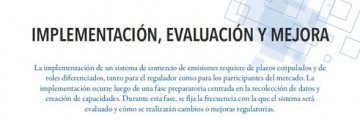In light of the forthcoming pilot phase of the Mexican Emissions Trading System (ETS) set to begin in 2020, the project “Preparation of an Emissions Trading System in Mexico” (SiCEM) has been conducting a series of activities which include the development and dissemination of relevant information regarding an ETS.
An Emissions Trading System is a key pillar in the advancement of low-carbon development and the achievement of sectoral Climate targets in Mexico. Its strength resides in that it creates a trust-worthy (with robust Monitoring, Reporting and Verification [MRV] systems) and flexible (allowing companies to decide on the most cost-effective way of achieving compliance) context to reduce Greenhouse Gas emissions.
The first batch of previously published factsheets describes the basic ETS elements in detail, such as the cap or the allowance allocation method. In this series, we dig deeper into the design elements that strengthen the System’s environmental integrity, stability and compliance, as well as those that provide greater flexibility for companies to develop their carbon management strategies.

Among the elements necessary to achieve compliance and strengthen confidence on the ETS lies a robust MRV system, key to obtaining accurate emissions data from participants. Additionally, it is important to establish monitoring and evaluation mechanisms to assess the operation, results and impacts of the instrument, and to revise the ETS design and regulation according to the short-comings and opportunities identified.
The stability and effectiveness of an ETS is linked, among others, to the allowance market price. The reason is as follows: an extremely low price doesn’t create economic incentives for companies to transition to low-carbon processes; on the other hand, an extremely high price could preclude installations from compliance. Risks associated to such price volatility can be managed through price-based or quantity-based price control mechanisms.
Additionally, mechanisms exist which give companies greater flexibility in their carbon management strategy by extending the compliance period. Linking ETS from different jurisdictions increases market size and liquidity, potentially diminishing abrupt allowance market price changes, as well as offers companies a greater number of alternatives to meet their compliance obligations.
A detailed description of the mentioned mechanisms can be found in the present factsheets. These were developd using as a reference information from renown sources like the International Carbon Action Partnership (ICAP), the Partnership for Market Readiness (PMR) and the International Emissions Trading Association (IETA), as well as practical lessons learnt from several jurisdictions with experience implementing an ETS, such as the European Union and the State of California. Additional studies covering a variety of technical issues be published in the “IKI-Alliance Mexico” blog in the coming months.
For more information, please contact us at: Comercio.Emisiones-MX[AT]giz.de
Click on the images below to download the publications (in spanish):






